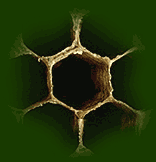
Posted on 03/27/2007 11:10:24 AM PDT by anymouse
One of the most bizarre weather patterns known has been photographed at Saturn, where astronomers have spotted a huge, six-sided feature circling the north pole.
Rather than the normally sinuous cloud structures seen on all planets that have atmospheres, this thing is a hexagon.
The honeycomb-like feature has been seen before. NASA's Voyager 1 and 2 spacecraft imaged it more than two decades ago. Now, having spotted it with the Cassini spacecraft, scientists conclude it is a long-lasting oddity.
"This is a very strange feature, lying in a precise geometric fashion with six nearly equally straight sides," said Kevin Baines, atmospheric expert and member of Cassini's visual and infrared mapping spectrometer team at NASA's Jet Propulsion Laboratory, Pasadena, Calif. "We've never seen anything like this on any other planet. Indeed, Saturn's thick atmosphere, where circularly-shaped waves and convective cells dominate, is perhaps the last place you'd expect to see such a six-sided geometric figure, yet there it is."
The hexagon is nearly 15,000 miles (25,000 kilometers) across. Nearly four Earths could fit inside it. The thermal imagery shows the hexagon extends about 60 miles (100 kilometers) down into the clouds.
At Saturn's south pole, Cassini recently spotted a freaky human eye-like feature that resembles a hurricane.
"It's amazing to see such striking differences on opposite ends of Saturn's poles," said Bob Brown, team leader of the Cassini visual and infrared mapping spectrometer at the University of Arizona. "At the south pole we have what appears to be a hurricane with a giant eye, and at the north pole of Saturn we have this geometric feature, which is completely different."
The hexagon appears to have remained fixed with Saturn's rotation rate and axis since first glimpsed by Voyager 26 years ago. The actual rotation rate of Saturn is still uncertain, which means nobody knows exactly how long the planet's day is.
"Once we understand its dynamical nature, this long-lived, deep-seated polar hexagon may give us a clue to the true rotation rate of the deep atmosphere and perhaps the interior," Baines said.
saturn ... 6th planet
s-a-t-u-r-n....6 letters
Thanks for the link. Excellent Ken Miller (Brown Univ) lecture link there.
Giant bees

I just gave up beer this year. A couple of years ago I gave up ALL booze. That was a pain. Just beer is uncomfortable, but OK....so far.
always good to leave yourself an out like that. my girls gave up all sweets but ice cream : )
If that's the retainer nut, doesn't it belong on Uranus?
LOL!
Now we're getting somewhere.
bookmark for later reading
LOL... it took 32 posts before someone remembered to blame Bush...
actually, it's the force shield around Algore's super secret saturn sanctuary.
jw
It is proof that the Rove Systems Inc. Weathermatic is in operation.
Basalt columns.
Sorry to bust your love-fest with the hexagon D-Fendr, the circle provides the largest area for a given perimeter.
Also I don't think it can beat a cube for ease of stacking... With hexagon tubes you can never pack to the edge of the container regardless of the side of the hexagon.
However, you are correct, bees do use it ;-)
Note: Just adding, this is an old topic. Thanks anymouse.
|
Disclaimer: Opinions posted on Free Republic are those of the individual posters and do not necessarily represent the opinion of Free Republic or its management. All materials posted herein are protected by copyright law and the exemption for fair use of copyrighted works.